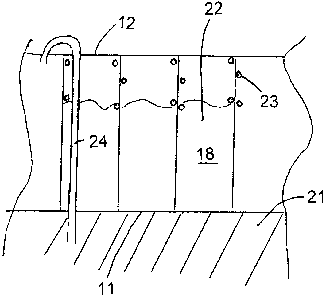Some of the information on this Web page has been provided by external sources. The Government of Canada is not responsible for the accuracy, reliability or currency of the information supplied by external sources. Users wishing to rely upon this information should consult directly with the source of the information. Content provided by external sources is not subject to official languages, privacy and accessibility requirements.
Any discrepancies in the text and image of the Claims and Abstract are due to differing posting times. Text of the Claims and Abstract are posted:
| (12) Patent Application: | (11) CA 2704301 |
|---|---|
| (54) English Title: | METHOD FOR LAND STABILIZATION |
| (54) French Title: | METHODE DE STABILISATION DU SOL |
| Status: | Deemed Abandoned and Beyond the Period of Reinstatement - Pending Response to Notice of Disregarded Communication |
| (51) International Patent Classification (IPC): |
|
|---|---|
| (72) Inventors : |
|
| (73) Owners : |
|
| (71) Applicants : |
|
| (74) Agent: | SMART & BIGGAR LP |
| (74) Associate agent: | |
| (45) Issued: | |
| (22) Filed Date: | 2010-05-20 |
| (41) Open to Public Inspection: | 2010-12-22 |
| Availability of licence: | N/A |
| Dedicated to the Public: | N/A |
| (25) Language of filing: | English |
| Patent Cooperation Treaty (PCT): | No |
|---|
| (30) Application Priority Data: | ||||||
|---|---|---|---|---|---|---|
|
Land is stabilized by laying an elongate generally flat mat onto the
ground where the mat is formed from strips of material arranged side by side
and
connected at spaced positions longitudinally to define a honeycomb structure
with
top and bottom surfaces of the mat defined by edges of the strips. The mat is
unrolled from a supply and laid onto the ground so that open empty tubular
cells
stand upwardly from the surface to be partly filled with top soil. The mat is
shaped
into the required rectangular strips to lie side by side in butting
arrangement by
locating pins in the ground. Seed attached to the mat grow in the soil and
ground to
effect stabilization.
Note: Claims are shown in the official language in which they were submitted.
Note: Descriptions are shown in the official language in which they were submitted.

2024-08-01:As part of the Next Generation Patents (NGP) transition, the Canadian Patents Database (CPD) now contains a more detailed Event History, which replicates the Event Log of our new back-office solution.
Please note that "Inactive:" events refers to events no longer in use in our new back-office solution.
For a clearer understanding of the status of the application/patent presented on this page, the site Disclaimer , as well as the definitions for Patent , Event History , Maintenance Fee and Payment History should be consulted.
| Description | Date |
|---|---|
| Application Not Reinstated by Deadline | 2015-05-20 |
| Time Limit for Reversal Expired | 2015-05-20 |
| Deemed Abandoned - Failure to Respond to Maintenance Fee Notice | 2014-05-20 |
| Inactive: Office letter | 2011-12-01 |
| Letter Sent | 2011-12-01 |
| Appointment of Agent Requirements Determined Compliant | 2011-12-01 |
| Revocation of Agent Requirements Determined Compliant | 2011-12-01 |
| Inactive: Office letter | 2011-12-01 |
| Inactive: Office letter | 2011-12-01 |
| Appointment of Agent Request | 2011-11-18 |
| Revocation of Agent Request | 2011-11-18 |
| Application Published (Open to Public Inspection) | 2010-12-22 |
| Inactive: Cover page published | 2010-12-21 |
| Inactive: IPC assigned | 2010-12-08 |
| Inactive: IPC assigned | 2010-07-07 |
| Inactive: First IPC assigned | 2010-07-07 |
| Inactive: IPC assigned | 2010-07-07 |
| Inactive: IPC assigned | 2010-07-07 |
| Application Received - Regular National | 2010-06-16 |
| Filing Requirements Determined Compliant | 2010-06-16 |
| Inactive: Filing certificate - No RFE (English) | 2010-06-16 |
| Small Entity Declaration Determined Compliant | 2010-05-20 |
| Abandonment Date | Reason | Reinstatement Date |
|---|---|---|
| 2014-05-20 |
The last payment was received on 2013-05-13
Note : If the full payment has not been received on or before the date indicated, a further fee may be required which may be one of the following
Please refer to the CIPO Patent Fees web page to see all current fee amounts.
| Fee Type | Anniversary Year | Due Date | Paid Date |
|---|---|---|---|
| Application fee - small | 2010-05-20 | ||
| Registration of a document | 2011-11-16 | ||
| MF (application, 2nd anniv.) - small | 02 | 2012-05-22 | 2012-05-04 |
| MF (application, 3rd anniv.) - small | 03 | 2013-05-21 | 2013-05-13 |
Note: Records showing the ownership history in alphabetical order.
| Current Owners on Record |
|---|
| RHINOKORE COMPOSITES MANUFACTURING PARTNERSHIP |
| Past Owners on Record |
|---|
| PAUL DAGESSE |